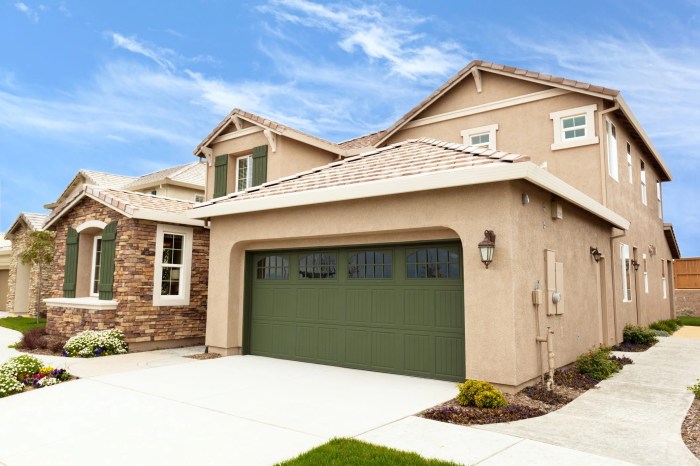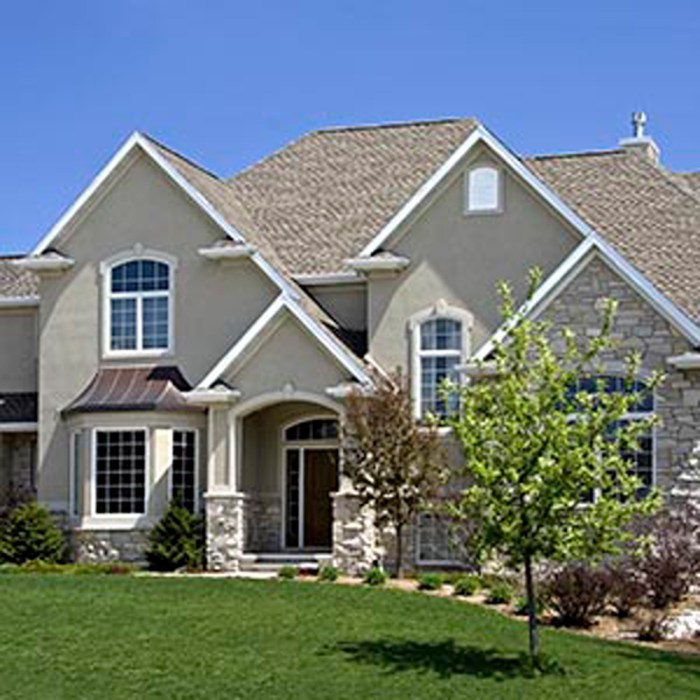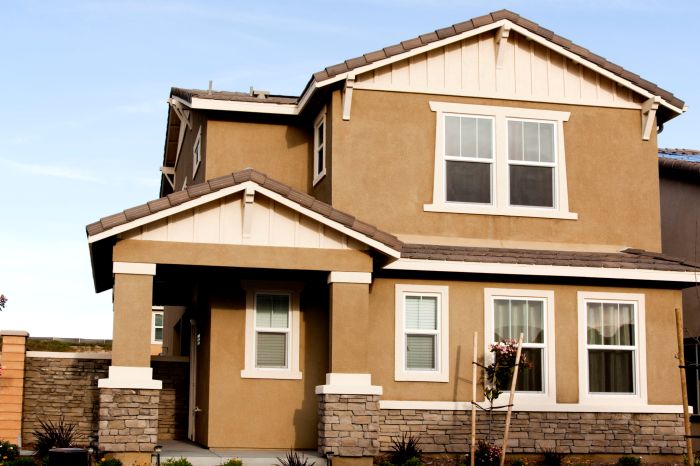Exploring the Beauty of House Stucco Siding
House stucco siding, a versatile and timeless choice for home exteriors, offers a unique blend of durability and aesthetic appeal. From its origins to modern applications, let's delve into the world of stucco siding and uncover its many benefits and intricacies.
As we navigate through the various aspects of stucco siding, we'll discover the key factors that make it a popular choice among homeowners seeking a stylish and long-lasting solution for their houses.
Overview of House Stucco Siding
Stucco siding is a popular choice for home exteriors due to its durability, versatility, and aesthetic appeal. It is a type of plaster that is applied to the exterior walls of a building to create a smooth, seamless finish. Stucco siding can be made from a variety of materials, such as cement, sand, and lime, and is typically applied in multiple coats to achieve the desired thickness and texture.
Benefits of Stucco Siding
- 1. Durability: Stucco siding is known for its long-lasting durability, able to withstand harsh weather conditions and resist damage from moisture, insects, and fire.
- 2. Low Maintenance: Once properly applied, stucco siding requires minimal maintenance compared to other siding materials, such as wood or vinyl.
- 3. Energy Efficiency: Stucco siding can help improve the energy efficiency of a home by providing an extra layer of insulation, helping to regulate indoor temperatures.
Types of Stucco Finishes
- 1. Smooth Finish: A classic, sleek finish that provides a clean and modern look to the exterior of a house.
- 2. Textured Finish: This finish adds depth and visual interest to the walls, creating a more rustic or traditional appearance.
- 3. Sand Finish: Incorporating sand into the stucco mixture results in a textured finish that resembles the grainy appearance of sand.
- 4. Dash Finish: This finish involves throwing small pebbles or stones onto the wet stucco to create a rough, textured surface.
Installation Process

Installing stucco siding on a house involves several steps to ensure a durable and aesthetically pleasing finish. Proper preparation work is crucial before applying stucco to the exterior, and understanding the curing and finishing process is essential for a successful installation.
Preparation Work
- Inspect the existing exterior for any damage or imperfections that need to be repaired before applying stucco.
- Clean the surface thoroughly to remove any dirt, debris, or loose paint that could affect the adhesion of the stucco.
- Apply a weather-resistant barrier and metal lath to provide a stable base for the stucco to adhere to.
- Install control joints to prevent cracking as the stucco cures and expands or contracts with temperature changes.
Curing and Finishing Process
- Once the stucco is applied, it needs time to cure properly. This process typically takes several days, during which the stucco should be kept moist to prevent it from drying out too quickly.
- After the stucco has cured, the finishing process begins. This may involve applying a textured finish, painting the stucco, or adding decorative elements to enhance the appearance of the siding.
- Regular maintenance, such as cleaning and inspecting the stucco siding, is important to ensure its longevity and appearance over time.
Maintenance and Care
Maintaining your house stucco siding is essential to prolong its lifespan and keep it looking great. Here are some tips on how to care for your stucco siding.
Regular Inspections
- Inspect your stucco siding at least once a year to check for any cracks, chips, or damage.
- Look for any discoloration or water stains that could indicate moisture issues.
- Check for any vegetation growing near the siding as it can cause damage over time.
Cleaning and Washing
- Regularly clean your stucco siding with a gentle detergent and water solution to remove dirt and grime.
- Avoid using high-pressure washers as they can damage the stucco surface.
- Rinse the siding thoroughly after cleaning to prevent residue buildup.
Repairing Damage
- Address any cracks or chips in the stucco promptly to prevent water infiltration.
- Use a stucco patching compound to fill in small holes and imperfections.
- Consult a professional for larger repairs or extensive damage to ensure proper restoration.
Cost Considerations

When it comes to installing stucco siding on a house, it's important to consider the various cost factors involved to make an informed decision. Let's break down the costs and compare them with other popular siding materials to understand the long-term savings associated with stucco siding.
Cost Factors for Installing Stucco Siding
- Material Costs: The cost of stucco material itself can vary depending on the quality and type of stucco chosen.
- Labor Costs: Hiring professionals for the installation process can add to the overall cost.
- Preparation Costs: Any necessary repairs or preparation work needed before applying stucco can impact the total cost.
- Finishing Costs: Adding finishing touches like painting or texturing can also contribute to the final price.
Comparison with Other Siding Materials
- Vinyl Siding: While vinyl siding may have a lower initial cost, it may not be as durable as stucco in the long run.
- Wood Siding: Wood siding can be more expensive upfront and requires more maintenance compared to stucco.
- Fiber Cement Siding: Fiber cement siding is a durable option but can be more costly than stucco.
Long-Term Cost Savings with Stucco Siding
- Energy Efficiency: Stucco siding can help improve energy efficiency in the home, resulting in lower energy bills over time.
- Durability: Stucco is a durable material that requires minimal maintenance, reducing long-term repair costs.
- Curb Appeal: The timeless look of stucco can increase the value of your home, offering a return on investment in the future.
Wrap-Up

In conclusion, house stucco siding stands out as a practical and visually pleasing option for enhancing the exterior of any home. With its durability, cost-effectiveness, and timeless charm, stucco siding continues to be a top choice for those looking to redefine their living spaces with elegance and sophistication.
FAQ Resource
How do I maintain stucco siding?
To maintain stucco siding, regularly inspect for cracks or damage, clean with a mild detergent and soft brush, and repaint every few years to keep it looking fresh.
What are common issues with stucco siding?
Common issues include hairline cracks, efflorescence (white deposits), and mold growth. These can be addressed by timely repairs and proper maintenance.
How often should stucco siding be inspected?
Stucco siding should be inspected at least once a year to check for any damage, water penetration, or signs of wear and tear that may require attention.




